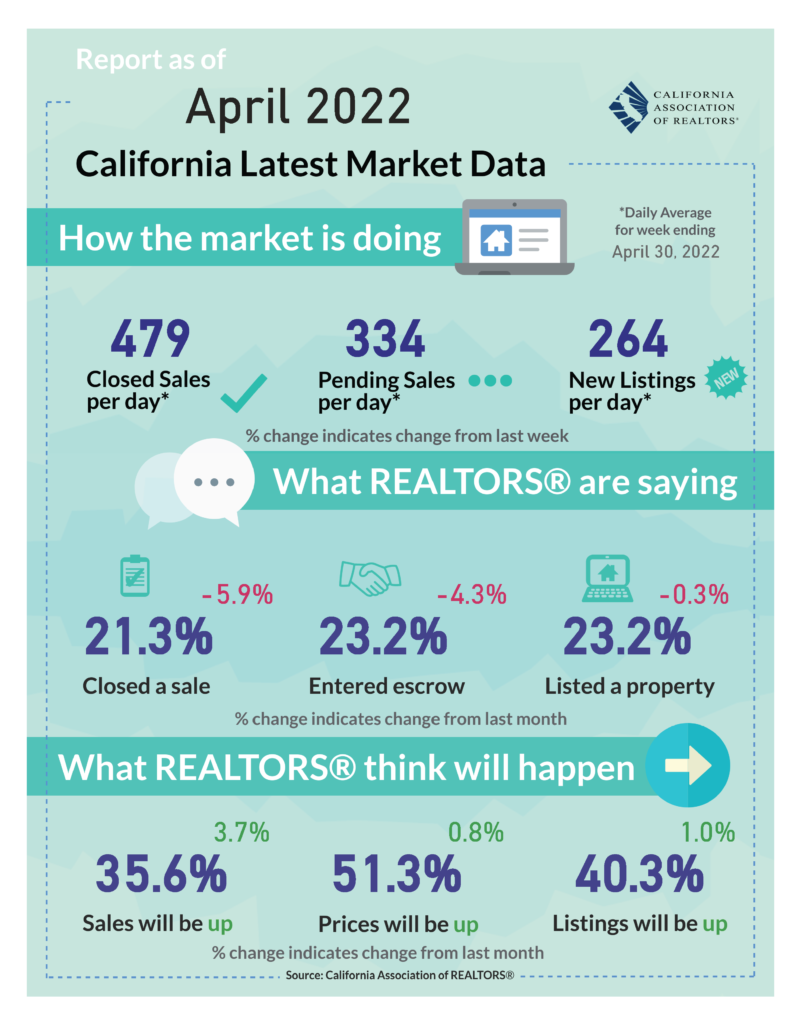
California housing market shrugging off challenges thus far: Despite a significant jump in mortgage rates, there are myriad signs of robust buyer demand in the latest weekly data. Some buyers may be feeling a sense of urgency to complete their transactions before rates rise further next year. The percentage of homes closing above asking price remains elevated at 72% of transactions last week. In addition, the median days on market for homes sold last week held steady at just 11 days. That means that the market was more competitive during the final week of April 2022 than it was during the summer of 2021.
Genuine improvement in inventory during past few weeks: Although California has been experiencing a seasonal uptick in inventory for the past few months, growth in active listings over the past few weeks has become much more meaningful. California ended April with nearly 30,000 homes available for sale across the MLS, collectively. That represents more than a 12% increase in inventory–the largest gain since before the pandemic began. That still leaves the state well behind pre-pandemic levels of available listings, but the acceleration in the pace of inventory coming online means that buyers will begin to have more options to choose from than they’ve seen in several years.
Economic growth dipped negative for the first time since the recovery began: In the first sign of cracks in the broader economy, real gross domestic product (GDP)–the primary measure of economic activity–fell for the first time since the recovery began in the second half of 2020. Overall, the economy shrank by a relatively modest 1.4% on an annualized basis, mostly from a larger international trade gap between imports and exports. Impressively, real consumer spending offset some of this decline despite rising inflation and ongoing supply chain challenges. Still, as government support wanes, consumers have had to rely more heavily on savings to maintain current spending levels, which suggests that we may not be able to sustain current levels of household spending indefinitely.
Job openings remain elevated, and businesses are still having difficulty filling them: Unemployment has dipped into the low single-digits, and the labor market remains tight.Last month, there was still more than 5 million more job openings than there are unemployed workers looking for work. This has led to ongoing wage growth (average hourly wages grew by an additional 5% last month from the year before–adding to already-increased pressure on inflation, which jumped to another 40-year high last month. Core inflation did stabilize somewhat, but with an already-hawkish stance by the Fed, a very tight labor market suggests that the rate environment will continue to trend up as they try to get consumer prices under control.
The Federal Reserve remains poised for several more interest rate hikes: The Federal Reserve will meet this week and they have all but assured us of a 50 basis point increase in their target rate, which would bring it to 1.00%. Given that the Fed has been relatively transparent about this move and that the market has already priced in roughly 200 basis points of Federal Reserve rate increases into 2- and 10-year treasuries, the announcement should not have a dire impact on the market. However, it does signal that the Fed remains committed to fighting inflation and that rates are likely to trend higher as they continue to tighten.
Mortgage applications have peaked a will likely weigh on home sales in the future: Mortgage applications have been falling from the 12-year highs reaches in 2021 for some time. However, in recent weeks, the decline in buyer demand has accelerated in the face of interest rates that have climbed as high as 5.41% according to daily quotes. As a result, new purchase applications have dipped, not just below 2020 and 2021, but also below pre-pandemic levels for the first time since the initial shelter in place orders were issued more than two years ago. This suggests that, although the current closed and pending sales figures remain robust, higher rates and slower economic growth will likely catch up to home sales later this year.
